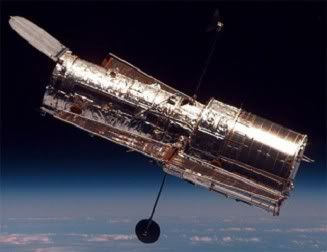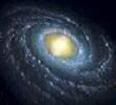Post by glactus on Mar 3, 2008 11:30:23 GMT

Image above: The faraway galaxy, HUDF-JD2 (encircled), is not seen in Hubble's visible light image (upper right), but was detected using Hubble's near infrared camera and multi-object spectrometer (lower left). It appears even brighter at the longer infrared wavelengths, as revealed by the Spitzer infrared camera (lower right). The upper left image combines these three views.
Two of NASA's Great Observatories, the Spitzer and Hubble Space Telescopes, have teamed up to "weigh" the stars in several distant galaxies. One of these galaxies, among the most distant ever seen, appears to be unusually massive and mature for its place in the young universe.

The Spitzer space telescope
This came as a surprise to astronomers. The earliest galaxies in the universe are commonly thought to have been much smaller associations of stars that gradually merged to build large galaxies like our Milky Way.

The Hubble space telescope
"This galaxy, named HUDF-JD2, appears to have 'bulked up' amazingly quickly, within the first few hundred million years after the big bang. It made about eight times more mass in stars than are found in our own Milky Way today, and then, just as suddenly, it stopped forming new stars," said Dr. Bahram Mobasher of the Space Telescope Science Institute, Baltimore, and the European Space Agency, Paris.
The galaxy was pinpointed among approximately 10,000 others in a small patch of sky called the Hubble Ultra Deep Field. The galaxy is believed to be about as far away as the most distant known galaxies. It represents an era when the universe was only 800 million years old. That is about five percent of the universe's age of 14 billion years.
Scientists studying the Ultra Deep Field found this galaxy in Hubble's infrared images. They expected it to be young and small, like other known galaxies at similar distances. Instead, they found evidence the galaxy is remarkably mature and much more massive. Its stars appear to have been in place for a long time.
Hubble's optical-light Ultra Deep Field image is the deepest image ever taken, yet this galaxy was not evident. This indicates much of the galaxy's optical light has been absorbed by traveling billions of light-years through intervening hydrogen gas.

The Grand Spiral
credits:
This article has been adapted from materials provided by NASA/Jet Propulsion Laboratory.
This is part text only. See image, full text and all scientists involved at sciencedaily.com
www.sciencedaily.com/releases/2005/10/051003233710.htm
Galaxy image credit: NASA/ESA/ JPL-Caltech
Spitzer image: www.star.le.ac.uk/edu/Root_folder/artspitzer.jpg
Hubble image: michaelgr.files.wordpress.com/2007/05/hubble-space-telescope-001.jpg



